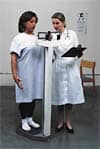Palmetto GBA has issued its draft Local Coverage Determination (LCD) for coverage of sleep studies, mirroring much of CMS’ National Coverage Determination, released in March. The draft, “Polysomnography and Sleep Studies for Testing Sleep and Respiratory Disorders,” which is applicable to California, Nevada, and Hawaii, doesn’t contain any drastic new home testing policy, but it does leave out details that have been addressed in previously released home testing policies, including information about RDI and G-Codes.
AHI is mentioned in the policy but RDI is absent. The policy states: "The AHI is equal to the average number of episodes of apnea and hypopnea per hour and must be based on a minimum of 2 hours of sleep recorded by polysomnography or by unattended home sleep testing using an FDA approved Type II, III, or IV portable device recording at least 3 channels using actual recorded hours of sleep (i.e., the AHI may not be extrapolated or projected)."
According to Christian Kiely, Marketing Manager, Fisher & Paykel Healthcare Inc, "There is no reference to an RDI in this policy and that could present some challenges. The policy requires an AHI to be generated using ‘actual recorded hours of sleep.’ However [many] Type III and Type IV devices do not offer sleep staging, therefore would not be able to generate a true AHI. CMS has typically used the RDI metric to define the scoring that is obtained from Type III and IV HST devices which document respiratory events over ‘recorded time,’ not ‘recorded hours of sleep.’ As written this would pretty much exclude the use of [many] Type III and Type IV HST devices." Exceptions would include the Watch-PAT100 and Watch-PAT200, says Gary Sagiv, vice president, Itamar Medical. "The Watch-PAT100 and Watch-PAT200 are the only Level III and IV devices that measure actual sleep time or actually recorded hours of sleep and have full FDA approved sleep staging," he says. "The AHI on both these devices are generated from the actual sleep time."
The draft LCD furthermore addresses who can perform testing: “Performance of home sleep testing is limited to FDA-cleared devices furnished with adequate patient instruction and support to assure successful completion of the studies. Provision of the device, patient instruction and support can be provided by accredited sleep centers as well as independent diagnostic testing facilities (IDTF) and other entities that can demonstrate use of FDA-approved devices, inspection of the devices, and the patient support activities required. The provider may be subject to post payment audit to document these activities.”
“By saying ‘and other entities,’ they [Palmetto] seem to potentially be allowing other parties to perform testing outside of the normal entities of accredited sleep centers and IDTFs,” says Landon Pendleton, director of product development, Instant Diagnostic Systems Inc. Despite the language, this potential “window to other entities” has yet to be clarified.
Palmetto’s draft LCD policy also states that the DMACS (Durable Medical Equipment Administrative Contractors) are responsible for providing coverage guidance on CPAP devices. The Palmetto draft includes the following information from the DMACS published policy on the standards of credentialing for individuals who interpret sleep testing results for the coverage of CPAP.
“Home sleep testing must be interpreted by a physician who holds either:
a) Current certification in sleep medicine by the American Board of Sleep Medicine; or
b) Current subspecialty certification in sleep medicine by a member board of the American Board of Medical Specialties; or
c) Completed residency of fellowship training by a program approved by an ABMS member board and has completed all the requirements for subspecialty certification in sleep medicine except the examination itself and only until the time of reporting of the first examination for which the physician is eligible; or
d) Active staff membership of a sleep center or laboratory accredited by the American Academy of Sleep Medicine or the Joint Commission.”
Under the draft LCD, a polysomnography and/or multiple sleep latency study is covered only if the patient has symptoms or complaints that suggest a diagnosis of narcolepsy, sleep apnea, or parasomnia.
Polysomnography for chronic insomnia is not covered under Palmetto’s draft LCD.
The entire draft LCD can be read online.
Palmetto will be accepting comments on the draft between October 30 and December 15, 2008.



